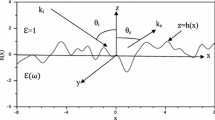Abstract
The radiative properties of three different materials surfaces with one-dimensional microscale random roughness were obtained with the finite difference time domain method (FDTD) and near-to-far-field transformation. The surface height conforms to the Gaussian probability density function distribution. Various computational modeling issues that affect the accuracy of the predicted properties were discussed. The results show that, for perfect electric conductor (PEC) surfaces, as the surface roughness increases, the magnitude of the spike reduces and eventually the spike disappears, and also as the ratio of root mean square roughness to the surface correlation distance increases, the retroreflection becomes evident. The predicted values of FDTD solutions are in good agreement with the ray tracing and integral equation solutions. The overall trend of bidirectional reflection distribution function (BRDF) of PEC surfaces and silicon surfaces is the same, but the silicon’s is much less than the former’s. The BRDF difference from two polarization modes for the gold surfaces is little for smaller wavelength, but it is much larger for the longer wavelength and the FDTD simulation results agree well with the measured data. In terms of PEC surfaces, as the incident angle increases, the reflectivity becomes more specular.
Similar content being viewed by others
References
ZHANG Z M. Nano/microscale heat transfer [M]. New York: McGraw-Hill, 2007: 23–59.
KNOTTS M E, O’DONELL K A. Measurements of light scattering by a series of conducting surfaces with one-dimensional roughness [J]. Journal of the Optical Society of America A, 1994, 11(2): 697–710.
SHEN Y J, ZHU Q Z, ZHANG Z M. A scatterometer for measuring the bidirectional reflectance and transmittance of semiconductor wafers with rough surfaces [J]. Review of Scientific Instruments, 2003, 74(11): 4885–4892.
FENG Wei-wei, WEI Qing-nong. A scatterometer for measuring the polarized bidirectional reflectance distribution function of painted surfaces in the infrared [J]. Infrared Physics & Technology, 2008, 51(6): 559–563.
LEE H J, CHEN Y B, ZHANG Z M. Directional radiative properties of anisotropic rough silicon and gold surfaces [J]. International Journal of Heat and Mass Transfer, 2006, 49(23/24): 4482–4495.
TSANG L, KONG J A, DING K H. Scattering of electromagnetic waves—Vol.1: Theories and applications [M]. New York: Wiley, 2000: 326–289.
ZHOU Y H, ZHANG Z M. Radiative properties of semitransparent silicon wafers with rough surfaces [J]. ASME Journal of Heat Transfer, 2003, 125(3): 462–470.
TAFLOVE A, HAGNESS S C. Computational electrodynamics: The finite-difference time-domain method [M]. 3rd ed. Boston: Artech House, 2005: 167–234.
TANNEHILL J C, ANDERSON D A, PLETCHER R H. Computational fluid mechanics and heat transfer [M]. 2nd ed. Washington: Taylor & Francis, 1997: 324–378.
BERENGER J P. A perfectly matched layer for the absorption of electromagnetic waves [J]. Journal of Computational Physics, 1994, 114(2): 185–200.
ZHU Q Z, LEE H J, ZHANG Z M. Validity of hybrid models for the bidirectional reflectance of coated rough surfaces [J]. AIAA Journal of Thermophysics Heat Transfer, 2005, 19(4): 548–557.
LIU J, ZHANG S J, CHEN Y S. Prediction of radiative properties of patterned silicon wafers by solving Maxwell’s equations in the time domain [J]. Numerical Heat Transfer: Part B, 2003, 44(4): 329–345.
PATANKAR S V. Numerical heat transfer and fluid flow [M]. Washington: Hemisphere Publishing Corp, 1980: 136–192.
LIU J, ZHANG S J, CHEN Y S. Rigorous electromagnetic modeling of radiative interaction with microstructures using the FVTD algorithm [J]. International Journal of Thermophysics, 2004, 25(4): 1281–1297.
TORRANCE K E, SPARROW E M. Theory of off-specular reflection from roughened surfaces [J]. Journal of Optical Society of America, 1967, 57(9): 1105–1114.
Author information
Authors and Affiliations
Corresponding author
Additional information
Foundation item: Project(2009AA05Z215) supported by the National High-Tech Research and Development Program of China
Rights and permissions
About this article
Cite this article
Wang, Ah., Hsu, P.F. & Cai, Jj. Modeling bidirectional reflection distribution function of microscale random rough surfaces. J. Cent. South Univ. Technol. 17, 228–234 (2010). https://doi.org/10.1007/s11771-010-0035-1
Received:
Accepted:
Published:
Issue Date:
DOI: https://doi.org/10.1007/s11771-010-0035-1




